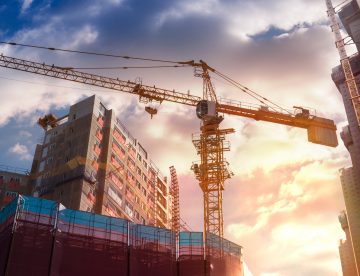
Sheriff Construction is delighted to announce that we’ve just secured our biggest brickwork contract to date. Valued at just over £6.1m, the deal will see our team supporting a major UK housebuilder at 5-acre regeneration site in Woolwich, London.
This is a significant win for Sheriff Construction as it cements the strong relationship we’ve built up with this client (who we’re not naming right now due to our protocols around confidentiality) and will provide our team with at least 2-years’ worth of secure work. The contract is also among the first to be secured since our company restructured, meaning the job will be managed through our sister company, Sheriff Brickworks. Read this week’s blog to find out more.

A new technology, using flying robots (drones) that work cooperatively like bees, might soon be something we see in use on a construction site.
Imitating some of the methods used by nature’s airborne builders, the technology (which has so far been tested in a lab) could ultimately be used for manufacturing and building – particularly in difficult-to-access or dangerous locations such as tall buildings or help with post-disaster relief works.
Take a look at this week’s blog to find out more…

A new England-wide employment scheme is looking to encourage more women to join the residential construction workforce and especially to go into site management roles.
Launched by the Home Builders Federation and the not-for-profit organisation, Women Into Construction, the scheme is offering women work placement opportunities on sites with access to support with childcare and training costs. The hope is that this will have the duel effect of reducing skills shortages in the industry and rebranding construction as a rewarding and practical career opportunity for people from all walks of life. Read on for more details…

Known as ‘Twelfth Night’, today officially marks the end of the festive period. For most people, this means that the lights and decorations will have been packed away, the chocolate box will be reduced to a few strawberry creams and normal working/ school days will have resumed.
While the return to a normal routine can feel like a natural comfort zone, for many people the prospect of the cold, dark winter months ahead can bring a dose of the blues and a lack of motivation that affects their personal and working lives.
If that’s you right now, here are a few tips for how you can stay motivated at work this January.

With all the political news focusing on the UK budget last week, you might have missed some amendments being made to the government’s Levelling Up Bill which will have implications for the construction industry.
Alongside measures that are supposed to help regenerate communities, speed up the delivery of new homes, improve wastewater facilities and give local people a greater say in how their neighbourhood looks, the government have presented what they’re calling BIDEN principles which should be applied to all new developments.
Intrigued as to what this means, we thought we’d find out more and use this week’s blog to explain.

This week, the Egyptian city of Sharm el-Sheikh saw world leaders, business leaders, climate activists, civil society representatives and others arrive for COP27 – the largest annual gathering on climate action. Running for two weeks (until 18th November), this United Nations conference is seeking renewed solidarity between countries to urgently tackle the global climate emergency and deliver on the Paris Agreement for people and the planet.
Approaches that can be made by energy intensive sectors such as oil, gas, steel and cement will be discussed on the conference’s ‘Decarbonisation Day’ (11th November) so we’ll be keeping a watch on what’s said. Meanwhile, we thought we’d take this as our theme for this week’s blog and look at five ways construction companies can lower their carbon footprint.

Lifting and moving heavy objects are part of normal working life on construction sites but, when managed badly, these everyday tasks can lead to damaging musculoskeletal disorders that leave workers struggling to stand, walk or sit down. For some, the injuries result in them having no option but to stop working in the industry altogether.
Because the health of workers can be affected to such a serious degree, inspectors from the Health and Safety Executive will be carrying out 1000 site inspections in October and November, particularly checking how workers are moving heavy or bulky materials. Read on for more details.

For most tradespeople, their van is not only a means of getting to and from work but also a vital part of their livelihood, holding many of the tools and materials they need to fulfil the day’s work.
How you fit out and organise your van can make a big difference in terms of the lifespan of your tools and equipment and also how efficient you are able to be on the job. With theft from vans being quite common, security is another major concern.
This week, we’re sharing five tips which could help you make sure your van is practical for your needs, well-organised and secure – in other words, fit for work.

Whether it’s a small-scale conversion project or a large commercial development, the contractors and sub-contractors involved will have an impact on the community they’re entering into.
In all likelihood, the work will be carried out in a location where some people live, work or spend their leisure time and that means there are several areas of concern which should be taking into consideration – particularly the appearance of the site, noise control and the logistical arrangements.
How members of the public react to these impacts will largely depend on how well a contractor engages with them. So, in this week’s blog, we’re exploring why keeping good relationships with local communities is so important to the success of any building project and what can be done to maintain a reputation as a considerate contractor.

